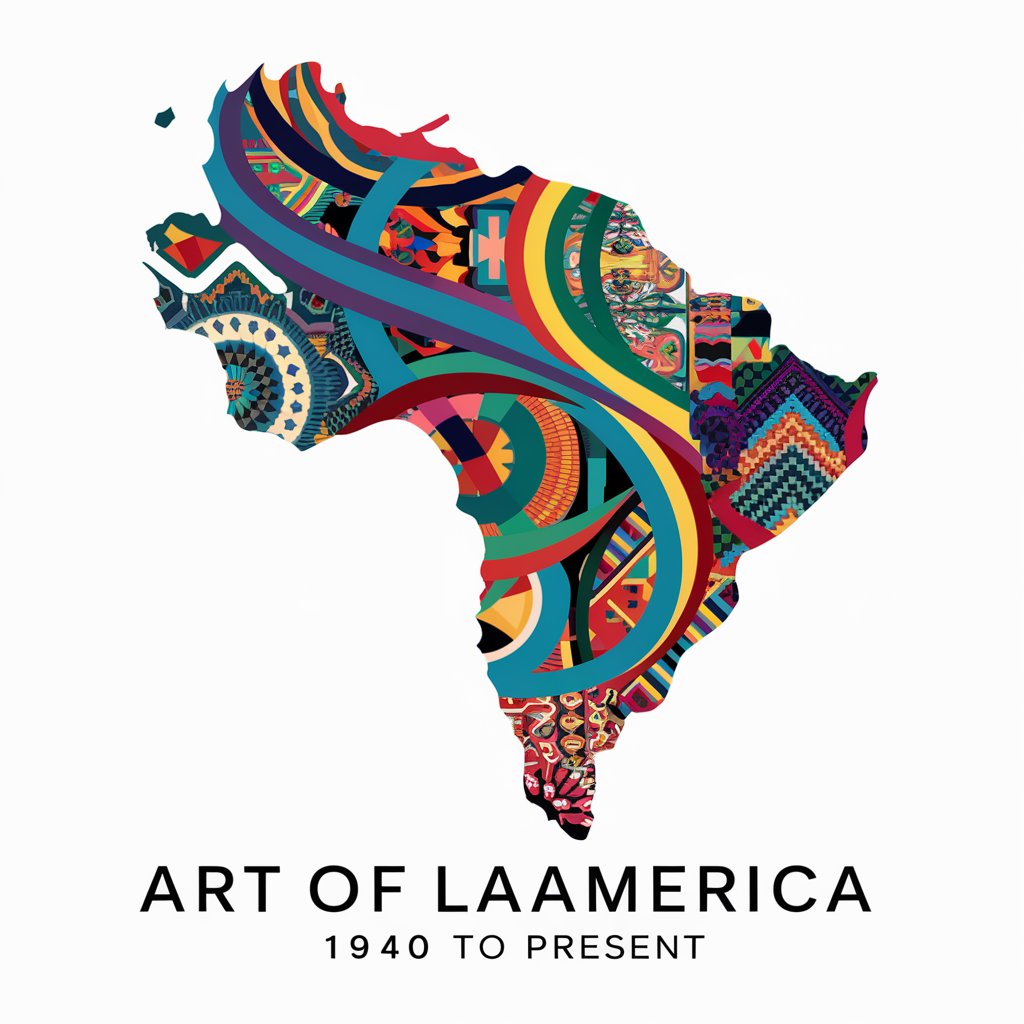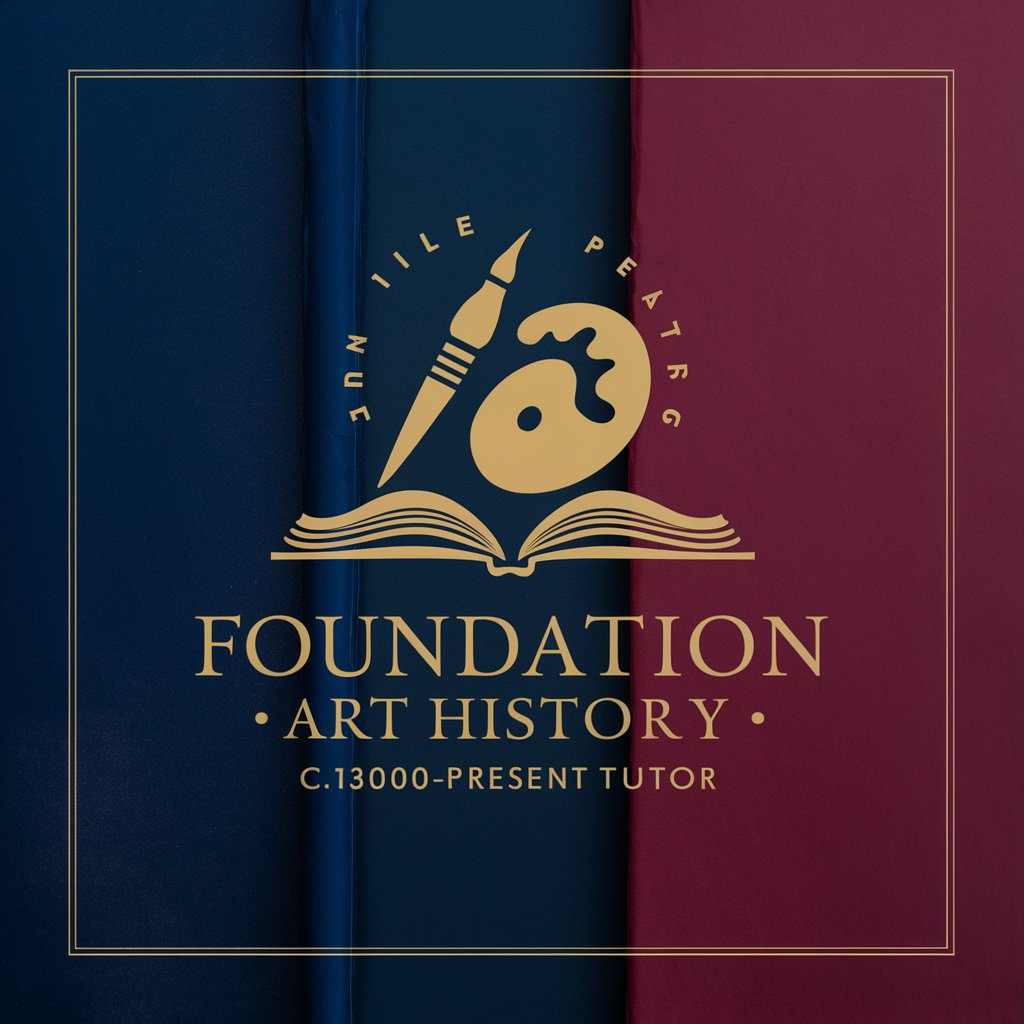Art of Latin America: 1940-Present Tutor - Latin American Art Insights

Welcome! Let's explore the vibrant world of Latin American art from 1940 to today.
Explore Latin American Art with AI
Can you explain the influence of political movements on Latin American art in the 1960s?
Describe the significance of geometric abstraction in the art of Latin America during the 1950s and 1960s.
How did the Mexican muralism movement impact artists in other Latin American countries?
What are some key characteristics of contemporary Latin American art from the 1990s to the present?
Get Embed Code
Overview of Art of Latin America: 1940-Present Tutor
The Art of Latin America: 1940-Present Tutor is designed to facilitate in-depth understanding and appreciation of Latin American art from the mid-20th century onwards. This period is marked by significant political, social, and cultural changes that influenced the artistic landscape across countries such as Mexico, Brazil, Argentina, and Cuba. The tutor's primary purpose is to educate users about the key artists, movements, and artworks that define this era, integrating historical context to enhance comprehension. For example, users can explore the impact of Mexican Muralism, Brazilian Modernism, or the Nueva Presencia movement, understanding each within its socio-political context. Powered by ChatGPT-4o。

Key Functions of Art of Latin America: 1940-Present Tutor
Educational Resource on Artists and Movements
Example
Users can learn about Frida Kahlo's role in Mexican art post-1940, her unique style and themes, and how she influenced subsequent generations. Additionally, the tutor covers artists like Roberto Matta of Chile, exploring his psychological landscapes and impact on surrealism.
Scenario
A university student preparing a thesis on the influence of political changes in 20th century Mexican art uses the tutor to gather detailed information on specific artists and movements, facilitating a well-rounded analysis.
Contextual Analysis of Artworks
Example
The tutor provides an analysis of Antonio Berni's 'Juanito Laguna' series to illustrate how art responded to social issues in Argentina. It breaks down the narrative, techniques, and symbolism Berni used to depict the struggles of the urban poor.
Scenario
An art critic writing an article about social realism in Latin American art utilizes the tutor to understand the depth of Berni's work and its relevance to Argentine history, enhancing the quality and depth of their critique.
Comparative Studies Across Regions
Example
It enables comparison between the kinetic art movements in Venezuela and the constructivist movements in Brazil, highlighting differences and similarities in approach and underlying philosophies.
Scenario
A curator designing an exhibit on Latin American kinetic artists uses the tutor to select representative works and articulate the curatorial narrative, ensuring visitors receive a comprehensive view of the region’s artistic diversity.
Ideal Users of Art of Latin America: 1940-Present Tutor
University Students and Academics
This group benefits immensely as the tutor serves as a scholarly resource that supplements their studies and research with in-depth essays, artist biographies, critical reviews, and contextual analyses pertinent to Latin American art from 1940 to the present.
Art Historians and Critics
Professionals in art history and criticism use the tutor to conduct comprehensive research, prepare lectures, write critical essays, and develop exhibitions that reflect an accurate and nuanced understanding of Latin American art phases and their global influences.
Curators and Cultural Programmers
Curators and programmers leverage the tutor’s extensive database to design exhibits and cultural programs that are informative, engaging, and accurately represent the artistic evolution and cultural narratives of Latin America over the decades.

Guidelines for Using Art of Latin America: 1940-Present Tutor
Accessing the Tutor
Begin by visiting yeschat.ai to start a free trial of Art of Latin America: 1940-Present Tutor, with no need for login or a subscription to ChatGPT Plus.
Identify Your Focus
Determine which specific area or artist from Latin American art history you are interested in exploring to tailor the information to your academic or personal learning goals.
Ask Detailed Questions
Formulate specific questions related to Latin American art from 1940 to the present. The more specific your query, the more precise and useful the information provided will be.
Utilize Advanced Features
Make use of the browsing capability for the latest scholarly articles, exhibition reviews, and academic discussions on your topic of interest.
Review and Reflect
After receiving your information, review the details and reflect on the insights provided. Revisit the tool for further queries to deepen your understanding and perspective.
Try other advanced and practical GPTs
Foundation Art History: c.1300-present Tutor
Explore Art History with AI

20th Century Photography to the Present Tutor
Empowering Photographic Knowledge with AI

Auto-Dress Knowledge
Elevate Your Brand with AI-Powered Marketing Strategies

Dress Detective
Unmask the Genuine with AI

Dress Up Doggy
Dress Up Your Dog with AI!

Senegal Dress Creator
Your AI-powered wedding dress designer

撒娇达人
Enhancing digital interactions with AI charm.

Online Dating Chat Advisor
Revolutionizing Romantic Connections with AI

Una Vida Online's chatbot
Empowering your digital venture with AI

Michael
Empowering your car buying experience

Customer Service Hotline
AI-powered customer service assistant for quick support

Talk to strangers
Connect Anonymously, Chat Globally

Common Questions About Art of Latin America: 1940-Present Tutor
What kind of topics can I explore with this Tutor?
You can explore a wide range of topics, including major artistic movements, significant artists, and pivotal artworks from Latin America between 1940 and the present. This includes examining socio-political contexts, stylistic developments, and cross-cultural influences.
How can this Tutor assist with academic research?
The Tutor can help refine research questions, suggest relevant scholarly sources, and provide detailed analyses of artistic trends and biographical information on artists, thus enhancing the depth and quality of your academic work.
Can this tool help me understand contemporary Latin American art?
Absolutely, the Tutor is equipped to provide insights into contemporary artistic practices, emerging artists, and current exhibitions, making it a valuable resource for keeping up-to-date with the latest in Latin American art.
What if I need information not readily available in the tool?
The Tutor's browsing capability allows for real-time searching of academic databases, online galleries, and digital archives to find the most current and comprehensive information available.
How detailed are the responses from this Tutor?
Responses are crafted to meet the needs of upper division and graduate students, providing in-depth, scholarly details suitable for academic study and professional research in the field of Latin American art.
